This is a list of horse breeds usually considered to originate or have developed in Canada and the United States. Some may have complex or obscure histories, so inclusion here does not necessarily imply that a breed is predominantly or exclusively from those countries.
| Name | Other names | Notes | Image |
|---|---|---|---|
| Alberta Wild Horse[1] | 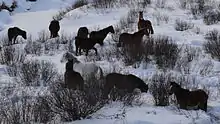 | ||
| American Bashkir Curly[2]: 434 |
|  | |
| American Belgian Draft[2]: 434 | .jpg.webp) | ||
| American Cream Draft[2]: 434 | .jpg.webp) | ||
| American Crème Horse[2]: 434 [3] | |||
| American Drum Horse[2]: 434 | |||
| American Indian Horse[2]: 434 | .jpg.webp) | ||
| American Miniature Horse[2]: 434 | 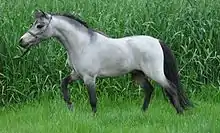 | ||
| American Paint Horse[2]: 435 | Paint Horse | 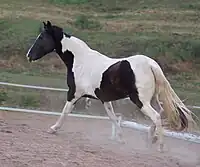 | |
| American Quarter Horse[2]: 435 | Quarter Horse[2]: 497 | 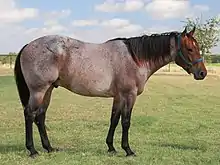 | |
| American Saddlebred[2]: 435 | .jpg.webp) | ||
| American Shetland Pony[2]: 435 |  | ||
| American Sorraia Mustang[2]: 435 | of Iberian origin, in the Colonial Spanish horse group; no connection to the Sorraia has been demonstrated[2]: 435 |  | |
| American Spotted[2]: 435 | |||
| American Spotted Paso[2]: 435 | |||
| American Thoroughbred | Thoroughbred | derives directly from the British Thoroughbred; some lines and some coat colors would not be eligible for registration in the General Stud Book[2]: 436 | .jpg.webp) |
| American Walking Pony[2]: 436 | |||
| American Warmblood[2]: 436 | .jpg.webp) | ||
| American White Horse[2]: 436 | |||
| Appaloosa[2]: 438 | 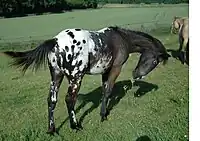 | ||
| Baca-Chica[3] | |||
| Banker[2]: 442 [3] | |||
| Blazer[2]: 445 | Modern breed of riding horse, bred particularly for ranch work; developed by Neil Hinck of Star, Idaho, from a single foundation stallion named Little Blaze.[2]: 445 | ||
| Camarillo White Horse[2]: 448 | |||
| Canadian[2]: 449 [3] | |||
| Canadian Pacer[2]: 449 | |||
| Canadian Pinto[2]: 449 | |||
| Canadian Rustic Pony[2]: 449 | |||
| Canadian Sport Horse[2]: 449 | |||
| Canadian Warmblood[2]: 449 [1] | |||
| Carolina Marsh Tacky[2]: 449 | Marsh Tacky[3] | ||
| Cerbat Mustang[2]: 450, 457 | |||
| Cherokee Horse[2]: 451 | |||
| Chickasaw[2]: 451 [4] | |||
| Chincoteague Pony[2]: 452 | Assateague Horse[2]: 452 | ||
| Choctaw Horse[2]: 453 [3] | |||
| Colonial Spanish[2]: 455 [3] | |||
| Colorado Ranger[2]: 457 | |||
| Conestoga Horse[2]: 443 | extinct | ||
| Cumberland Island Horse[2]: 459 | |||
| Florida Cracker Horse[2]: 466 | |||
| Galiceño[3] | |||
| Kanata Pony[2]: 478 | |||
| Kentucky Mountain Saddle Horse[2]: 479 | |||
| Kiger Mustang[2]: 480 | |||
| Lac La Croix Indian Pony[2]: 481 [1] |
| ||
| Missouri Fox Trotter[2]: 486 | |||
| Morab[2]: 487 | |||
| Morgan [2]: 487 | |||
| Morocco Spotted[2]: 487 | |||
| Mountain Pleasure Horse | |||
| Moyle[2]: 488 | A riding horse suitable for ranch work and trail riding descended from horses bred by Mormon people from Mustangs and Cleveland Bay kines, developed into its modern form by Rex Moyle. DNA markers indicate ancestry from Colonial Spanish stock. A unique characteristic is small frontal skull bosses, referred to as "horns" on their foreheads, a trait seen only in a few breeds.[2]: 487 [5]: 183 No stud-book or breed association.[5]: 181 | ||
| Mustang[2]: 488 | American Mustang[2]: 434 | ||
| Narragansett Pacer[2]: 488 | extinct | ||
| National Show Horse[2]: 488 | |||
| Nemaiah Valley Horse[1] | |||
| Newfoundland Pony[1][3] | |||
| Nez Perce Horse[2]: 489 | |||
| Nokota [2]: 490 | |||
| North American Sportpony | American Sport Pony[2]: 435 | ||
| Pony of the Americas[2]: 497 | Appaloosa Pony[2]: 438 | ||
| Pryor Mountain Mustang | Pryor Mountain[2]: 457 | ||
| Puerto Rican Paso Fino[3] | |||
| Quarab[2]: 497 | |||
| Quarter Pony[2]: 435 | |||
| Racking Horse[2]: 497 | |||
| Rocky Mountain Horse[2]: 498 | |||
| Sable Island Pony[2]: 499 | |||
| Santa Cruz[3] | |||
| Spanish Jennet Horse[2]: 477 | |||
| Spanish Barb[4] | The Spanish Barb Breeders Association is a registry for Colonial Spanish horses; eligible horses stand 140–150 cm and may be of any color[2]: 457 [6] |  | |
| Spanish Mustang[4] | |||
| Spanish Norman[2]: 504 | 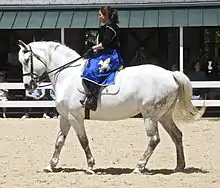 | ||
| Spotted Saddle Horse | National Spotted Saddle Horse[2]: 488 | ||
| Standardbred[2]: 436 |
| ||
| Sulphur[3] | |||
| Tennessee Walking Horse[2]: 507 | |||
| Tiger Horse[2]: 508 | A gaited, leopard-spotted riding horse, bred from Appaloosa, Paso Fino and Colonial Spanish stock; height 147–152 cm | ||
| Virginia Highlander[2]: 472 | |||
| Walkaloosa | derives from Tennessee Walking Horse and Appaloosa, displays leopard spots and ambling gait[2]: 512 | ||
| Welara[2]: 512 | |||
| Wilbur-Cruce[3] | |||
References
- 1 2 3 4 5 Breed data sheet: Canada: Horse. Domestic Animal Diversity Information System of the Food and Agriculture Organization of the United Nations. Accessed February 2019.
- 1 2 3 4 5 6 7 8 9 10 11 12 13 14 15 16 17 18 19 20 21 22 23 24 25 26 27 28 29 30 31 32 33 34 35 36 37 38 39 40 41 42 43 44 45 46 47 48 49 50 51 52 53 54 55 56 57 58 59 60 61 62 63 64 65 66 67 68 69 70 71 72 73 74 75 76 77 78 Valerie Porter, Lawrence Alderson, Stephen J.G. Hall, D. Phillip Sponenberg (2016). Mason's World Encyclopedia of Livestock Breeds and Breeding (sixth edition). Wallingford: CABI. ISBN 9781780647944.
- 1 2 3 4 5 6 7 8 9 10 11 12 13 Horses: North American Breeds. Pittsboro, North Carolina: The Livestock Conservancy. Archived 2 October 2023.
- 1 2 3 Breed data sheet: United States of America: Horse. Domestic Animal Diversity Information System of the Food and Agriculture Organization of the United Nations. Accessed February 2019.
- 1 2 Judith Dutson (2005). Storey's Illustrated Guide to 96 Horse Breeds of North America. North Adams, Massachusetts: Storey Publishing. ISBN 9781580176132.
- ↑ Wolf Schneider (Spring 1993). The Horses Called Spanish Barbs. El Palacio. 98: 34-49. Archived 9 May 2016.
This article is issued from Wikipedia. The text is licensed under Creative Commons - Attribution - Sharealike. Additional terms may apply for the media files.